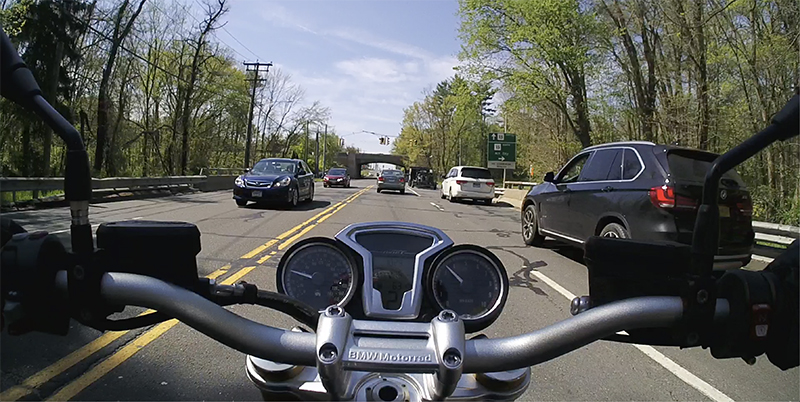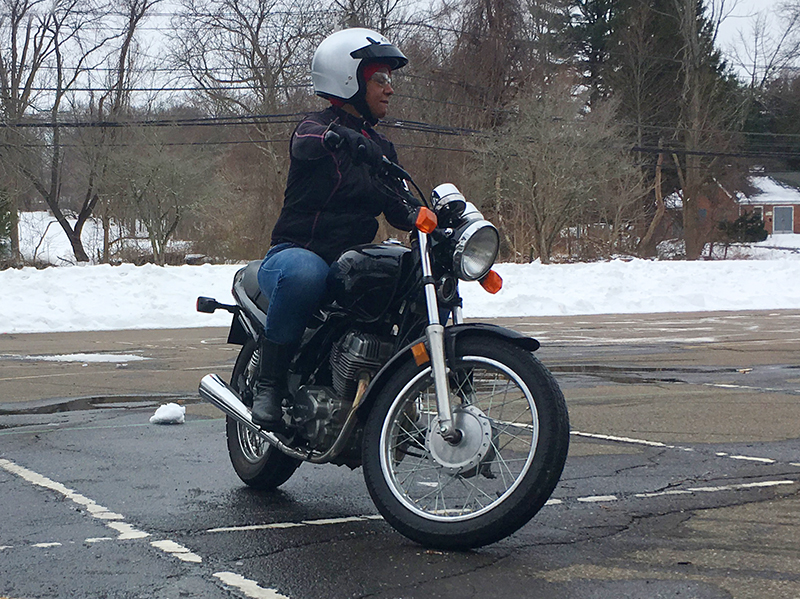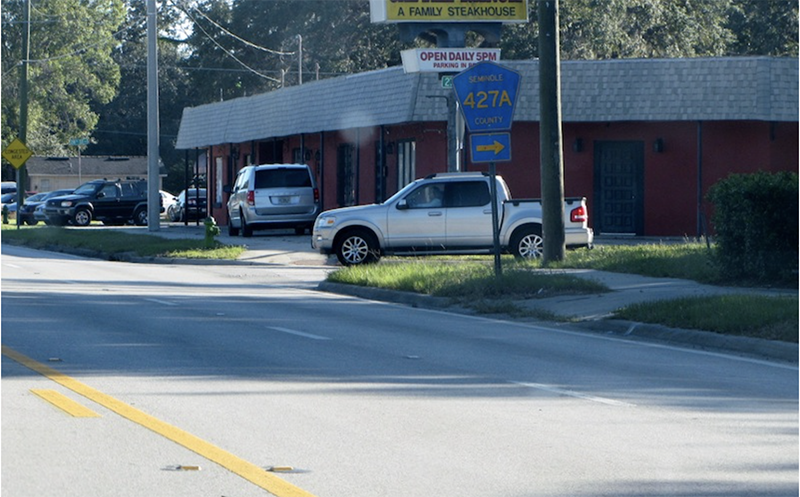Editor's note: This article was originally posted in August, 2012, but the same principals of riding safety and road hazards apply today. Find more articles about motorcycle safety and technique in the WRN Riding Right section.
Identifying Road Hazards
We all want to mount up on two wheels, feel the wind in our face, and enjoy the open air around us. We also want to have a safe ride. To help you have fun on your motorcycle and feel safe while doing it, here are five of the top hazards all motorcycle riders should be on the lookout for while traveling out on the road.

1. Blind Spots
Be sure not to ride in any vehicle’s blind spot—that is, the area around a vehicle that is not visible to the driver using his or her mirrors. It’s bad enough when a car driver doesn't turn and look when changing lanes in front of another car. Now think about that happening when the other car is a motorcycle. If you think you're riding in that gray zone, either speed up and get past the vehicle or slow down to allow the vehicle enough room to change lanes.
2. Uneven Road Surfaces
Road construction is a pain, but we all get stuck riding in it. If the lanes are uneven, try to stay in the same lane until the uneven lanes end. Also be on the lookout for divots in the road. These are often caused by a large truck dragging something from its undercarriage, leaving a depression in the road—sometimes for a good distance. Getting your bike caught up in indentations like these may cause your tire tread to “catch,” possibly leading to a loss of control.

3. Debris, Gravel, Oil, Sand, Slick Surfaces
Need I say more? Riding on two wheels is all about stability, and it doesn’t take much to lose that precious stability when riding on sand, gravel, oil, ice, or debris. If you're not careful when riding through these materials, you can easily lose traction, causing the bike to slide. If you can, stop and evaluate the surface. If it looks unsafe, find another way around. If you must ride through one of these road hazards, do so carefully and at a slow, steady, safe speed. Avoid leaning, and most importantly, don't brake or accelerate quickly or suddenly.

4. Side Roads
Why are side streets a road hazard? Because they're everywhere, and vehicles are turning out from them and in front of us constantly. Always look ahead to side roads, where you may see a vehicle waiting to enter the road in front of you. Expect that vehicles will not always see you, and plan your reaction. For example, you might think, “If that car pulls out, can I move to the left lane? Should I slow down in case they do?” Swerving is sometimes unavoidable but can be a hazard if there is a vehicle in the next lane or it isn't performed correctly. Don’t overreact, but be ready to react!

5. Intersections
Intersections are arguably the most dangerous road hazard for motorcyclists. After all, intersections can involve all four road hazards listed above. In an intersection, you need to be on the lookout for vehicles changing lanes around you (even though they're not supposed to), while also watching for debris, gravel, and oil in the roadway. You should be conscious of uneven surfaces, but you also need to watch for vehicles turning left in front of you and turning right into your path of travel. Traffic-light changes also necessitate that you be aware of vehicles stopping quickly or not stopping soon enough. Are you feeling overwhelmed yet? Don’t. Just take a deep breath and a big look around.
Intersections can combine many hazards into one, but having a plan of action and keeping a clear head will help you navigate through any hairy situations you may encounter.
The best thing to do in intersections—and every time you saddle up and ride—is to play the “What if...?” game in your mind. Think, “If a car pulls out in front of me, what will I do? How will I react?” The main thing is to be prepared and to avoid overreacting.
I have seen many crashes where a motorcyclist assumed a vehicle was not going to stop and their quick overreaction was to grab the front brake or slam on the rear brake, causing a skid (loss of traction.) Wrong move! Practice proper emergency braking so that you will automatically use good braking techniques when necessary.
Instead of panicking, always be sure to look ahead, assume vehicles don’t see you, and have your plan of action ready. If you see a vehicle approaching the intersection (or stop sign, yield sign, etc.), slow down and move to the opposite side of your lane. For example, if a vehicle is approaching from a side road on your right, move to the left side of your lane. This allows you more room to react and move if you need to. Soon enough, it will become second nature.

Suggestion for side roads—watch the tires. If they are moving, slow down, cover your brakes. Do not look at the driver’s face. They may say “ok” or look like they are paying attention. The tires tell you what their intentions are!
I was severely injured when a car pulled out in front of me, so I like to promote motorcycle safety. But I couldn’t bring myself to share this article.I would never recommend that someone pull over and assess a patch of gravel.”Yep it’s definitely gravel.”Obviously we want to avoid surfaces with reduced traction altogether but we don’t always have that option. The good news is if there was a patch of ice in the road you could safely ride across it as long as you minimize inputs to the controls (don’t turn or brake hard). Keep cool and aim your bike back to the nearest surface with some traction. Often this is 10 feet straight ahead of you, in which case, no problem! Otherwise, roll off throttle, grip the tank with your legs (please don’t stick your foot out, newbie, it’s not going to help), and ease through slowly! Your front brake is the quickest way to stop your motorcycle. Don’t picture a bicycle going over the handlebars. This is terrible advice. Obviously there are times when a rider should avoid using the front brake, but riders should be comfortable with using the front brake most often for stopping, not scared of flying over the handlebars (like the author).
Kinda surprised no one mentioned the following scenario. When riding on the freeway and a semi [tractor trailer] pulls into the passing lane to pass a slower semi do not follow him up alongside the semi being passed. Because now you’re boxed in. If anything happens ahead of them you can’t see it developing and you’re boxed in. If the two big trucks begin avoidance maneuvers one them may suddenly move into your lane and traffic behind you may not see the event start, leaving you with nowhere to go.I always wait for the semi in front of me to clear the semi being passed before I make my move. Get past the semi safely and quickly. Ever seen them have a tire blow out? Don’t ask how I know. As they say, “don’t go faster than your angels can fly.”
To figure out the movement/direction of a vehicle, don’t look at the driver, look at the front wheels of the vehicle for movement and direction. As a Facebook friend said, “we are invisible on a motorcycle.”
Someone lost a hubcap in front of me. Came right me but I was able to avoid it. The car behind me hit it.
For me I’m always worried about the motorcycle-eating potholes. Here in Hawaii the roads are terrible. They are trying put put an elevated rail system so they won’t repave the roads until it’s done. I’ve seen 2- to 3-foot potholes (about 3 to 4 inches deep) on major highways. And the steel plates they put down (and pull back up the next day) are huge and very slippery, and of course surrounded by loose gravel! Be akamai (smart) and ride safe please!
Animals. Dogs, cats, deer, coyotes, squirrels, elk, snakes. Partial list of creatures I’ve had to swerve or brake for. I’ll take a distracted driver any day over driving at dusk and seeing an adult elk standing alongside the pavement. That’ll get your attention.
Armadillos. They are kind of like rolling over a bowling ball.
Speaking from EMS standpoint the most calls I get are the lane jumping cars (don’t want to wait and suddenly come out of line into next lane) the can’t-find-what-I-am-looking-for-car, who slows down like they’re going to turn and and then decides to keep going or suddenly turns in opposite direction of what indicating. Give these drivers lots of room and expect them to do the unexpected. We get far too many calls to attend to motorcyclists who went through the back window of a car because the were following too closely and the driver did something unexpected, a well as too many calls for “I just didn’t see them.” They are never good calls. Expect to be hit so you can go to your escape plan. And please please, please wear your gear.
I recently read an article about “motion camouflage” that discussed how car drivers don’t see motorcycles because their motion relative to another vehicle disguises them. To reduce this invisibility the technique in #5 was the suggested lane change position. If we shift our profile relative to the car that might pull out into our path, it helps that driver see us. Making a change in our position relative to the driver and our background helps us stand out some. I always assume the car driver can’t see me and ride defensively at all times.
I always watch for cars that like to ride too close. I usually pull over and wave them on as many times they are in a hurry and try to pass you on the right. Better to be safe than get run off the road.
Road tar. This year twice we have slid going into a turn where there was road tar used to fill cracks. In hot weather the tar gets greasy and slick like oil!
In case of an emergency stop: Don’t hit the brakes to the max in blind panic. Use every inch of distance available – IF – you can’t swerve around the obstacle. And if collision is unavoidable. Do what you can with eyes wide open, but let go of the handlebars just before impact, and if possible stand up on the steps. Thus you’ll be launched over the car instead of smashing your head into it. And remember to adjust your speed to circumstances. Ride like you’re invisible.
Good article but, Kathlene, you are absolutely right! Distracted drivers are oblivious to other drivers. So, what makes you think they would even see a motorcyclist? We have to be the ones to be vigilant. I’ve blared my horn many times only to get an F-U from drivers on their phones. They do not care about anyone but themselves!I just posted on my FB wall today that it seems it’s more dangerous to allow water runoff from your yard than texting and driving fines here in California.Water runoff – up to $500 per day fineTexting & Driving – $20 for first offense and $50 for subsequent convictions. Ridiculous!
Nowadays, number 1 should be distracted drivers! Watch out for cell phone users especially.Give them a wide berth and keep your finger on the horn button. Also, if I am riding with a group, I will point at a car and give the “on the phone” hand signal (handmade to look like a phone receiver against my ear).I honked at someone once who was drifting into my lane. They were so into what the were doing that I startled them enough to make their phone fly into the backseat of their car.People on the phone while driving should receive a much higher fine and do community service. Second ticket—a weekend in jail, and third ticket—fines, jail and permanent loss of license.Until the government really cracks down on this, we as riders are all in far more serious danger than we have ever been.
Well said!
That’s my daughter! I’m glad that some things I told her sank in! She learned how to drive in a ’57 Chev modified, 3-speed Hurst shifter, 327 cubic inch, 4 bbl, etc., etc. You go, girl!
Good advise all the way around! There is one more thing that I do, at intersections and that is to use the three second rule before I move through the light, this will give you time to watch for any cars that may try to blow through the light. My hesitancy has more than likely saved my skin a time or two. The car sitting behind you may not like it but it is for their benefit too.
Good points in a great article! Particularly liked the points made about road hazards. I have seen many inexperienced riders stop at a traffic light, in the center of the lane (where all the oils accumulate from cars), plant one foot on that oil section and go down when the foot lost traction. There are many hazards on the road itself….always ride “ahead” and watch the road. Thank you for this article.Many, many years ago, an elderly man gave me an excellent piece of advice. “Dearie, always remember…you’re invisible while you ride that thing. You are invisible. Remember that and you’ll live to ride a long time.” Then he got on his Harley and roared off.His words have helped me more times than I can remember.
That was a great article and I certainly learned something from it. I just took a solo trip from Dania Beach, Fla., to Jacksonville, Fla, 759 miles round trip. At 8:30 a.m Sunday leaving Jacksonville I am approaching the on-ramp to I-295 South to Ft. Lauderdale and low and behold a lady on her cell phone doesn’t see me, but I’m glad I saw her and had enough room to move over and get out of her way. Always be prepared for the unexpected. I’m a lady rider, age 60.
Great.
I really liked the advice about intersections, as you are always head-to-head with opposing drivers who sometimes make up their own rules of the road. Telepathy is great if you have it. On straight way streets I like to stay in a bubble between vehicles giving myself at least a 4-second gap. Seeing what’s further ahead helps to know my position in traffic, but the guy behind me may not see what I do and if I have to stop quickly, he could end up on top of me. Practicing good road habits is especially valuable if you’re on two wheels, more than riding in a 4-wheel vehicle. It also sharpens your wits for driving on four wheels as well. Loved all the advice you can learn on here.